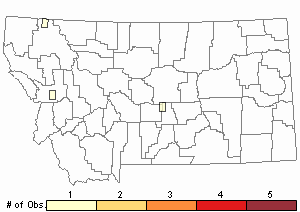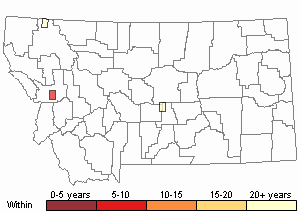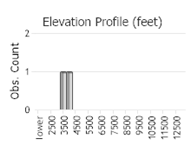View in other NatureServe Network Field Guides
NatureServe
Montana
Utah
Wyoming
Idaho
Wisconsin
British Columbia
South Carolina
Yukon
California
New York
An Orthotrichum Moss - Orthotrichum elegans
Other Names:
Orthotrichum speciosum var. elegans
General Description
Plants: Acrocarpous, growing in rather crowded clumps of upright shoots (FNA 2014), deep green to occasionally brown (Crum and Anderson et al. 1981). Stems sometimes reaching 22 mm in height (FNA 2014).
Leaves: Somewhat rigid, twisted and bent when dry, spreading, sometimes broadly, when damp, 2.3-3 mm in length, lance-shaped, occasionally slenderly so (FNA 2014), narrowing to the acute leaf tip or the leaf tip widely acuminate; leaf edges smooth, tightly rolled back almost to the leaf tip (FNA 2014).
Leaf Cells: Upper lamina of 1 cell-layer (FNA 2014), the cells chlorophyllous (Crum and Anderson et al. 1981), somewhat round and isodiametric (FNA 2014), with 1 or 2 small, cone-shaped papillae over each lumen; lower laminal cells somewhat long with thick, knobby walls (FNA 2014).
Diagnostic Characteristics
Variety elegans is small, has stems crowded, and capsules smooth and partially emerged to only slightly exserted. The typical variety grows in more open clumps, and has faintly 8-ribbed capsules with the capsules completely beyond the perichaetial bracts (FNA 2014). Additionally, the leaves are shorter and the capsules more slender in variety elegans (Crum and Anderson et al. 1981).
Range Comments
North American Range
AK, NT, BC to NL and NS, MO, MN to MI, OH to RI, NH and ME (FNA 2014). Known in Montana from Flathead and Golden Valley Counties (Elliott and Pipp 2016).
Observations in Montana Natural Heritage Program Database
Number of Observations: 3
(Click on the following maps and charts to see full sized version)
Map Help and Descriptions
Relative Density

Recency



 (Observations spanning multiple months or years are excluded from time charts)
(Observations spanning multiple months or years are excluded from time charts)
Habitat
On bark of evergreens, cottonwoods and other deciduous trees, occasionally on logs, wooden fences, and stones (Crum and Anderson et al. 1981). Elevation: approximately 660-3280 feet (FNA 2014).
Reproductive Characteristics
Autoicous. Seta twisted, 1-2 mm tall. Capsule 1.3-2 mm in length, partially emerged or exserted a small amount beyond the perichaetial bracts, without longitudinal ribs (FNA 2014), seldom obscurely pleated when dry (Crum and Anderson et al. 1981); stomata occurring at the capsule surface; exostome of 8 teeth, split to the bottom, curving back and downward (FNA 2014) or curved inward when dry (Crum and Anderson et al. 1981), with rough papillae; endostome processes 8, typically persistent throughout the capsule’s old age, with rough papillae. Calyptra cone-shaped, sheltering the full length of the capsule, with a few minutely-papillose hairs (FNA 2014).
References
- Literature Cited AboveLegend:
 View Online Publication
View Online Publication Crum, H.A. and L.E. Anderson. 1981. Mosses of Eastern North America. 2 volumes. Columbia University Press, New York. 1328 pp.
Crum, H.A. and L.E. Anderson. 1981. Mosses of Eastern North America. 2 volumes. Columbia University Press, New York. 1328 pp. Elliott, J.C. and A.K. Pipp. 2018. A Checklist of Montana Mosses (1880-2018). Updated 3 January, 2020. Montana Natural Heritage Program, Helena, Montana. 73 pp.
Elliott, J.C. and A.K. Pipp. 2018. A Checklist of Montana Mosses (1880-2018). Updated 3 January, 2020. Montana Natural Heritage Program, Helena, Montana. 73 pp. Flora of North America Editorial Committee, eds. 2014. Flora of North America North of Mexico. Volume 28. Bryophytes: Mosses, Part 2. Oxford University Press, Inc., NY. xxi + 702 pp.
Flora of North America Editorial Committee, eds. 2014. Flora of North America North of Mexico. Volume 28. Bryophytes: Mosses, Part 2. Oxford University Press, Inc., NY. xxi + 702 pp.
- Additional ReferencesLegend:
 View Online Publication
View Online Publication
Do you know of a citation we're missing? Elliot, J. C. 1993. Second checklist of Montana mosses. Unpublished report. U.S. Forest Service, Region 1. Missoula, MT. 45 pp.
Elliot, J. C. 1993. Second checklist of Montana mosses. Unpublished report. U.S. Forest Service, Region 1. Missoula, MT. 45 pp.
- Web Search Engines for Articles on "An Orthotrichum Moss"





